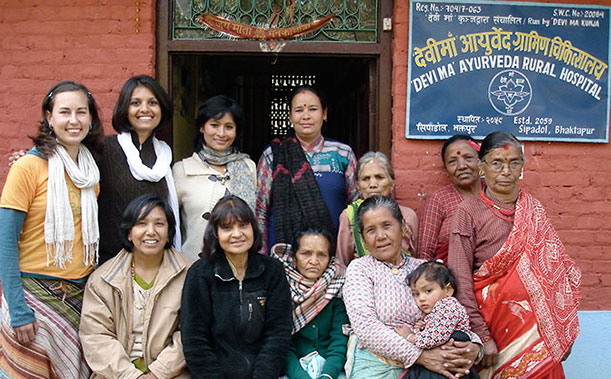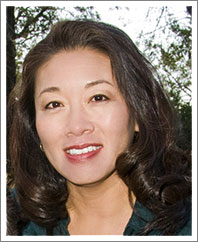An Ayurvedic Guide to Breast Health
By Vrinda Devani, MD
The breasts have been used in symbolism since time immemorial.1 They have represented love and fertility, as well as sex and pleasure. But in the deep recesses of our mind, for men and women alike, dream interpretation theories show that breasts symbolize something even more integral-our primal need for motherly love, support, security, care and nourishment, because their function as an organ is to give just that. They also symbolize a woman's innate desire to be beautiful and desired and, therefore, can have profound impacts on a woman's self image.2
Thus, the breasts not only serve physical needs of sexual intimacy and breastfeeding, but also our energetic needs. Likewise, the state of our breasts and changes in them are huge clues as to what emotions are being processed or need processing. In this way, caring for our breasts is to care for our soul. A beautiful statement by Susan Weed in her book, Breast Cancer? Breast Health!, sums this idea up: "We cannot nurture others fully, unless we nurture ourselves."
Read more...
About the author
As an Obstetrician and Gynecologist, Vrinda Devani, MD has a passion for women's health and empowering women towards vibrant health and living. She is a believer in unfolding the human body's potential through a blend of complementary and allopathic medicine. She has been extremely fortunate to study Ayurveda extensively under Dr. Vasant Lad and further her studies in Ayurvedic women's health with travels in Nepal with Dr. Sarita Shrestha. In addition to being a physician and certified Ayurvedic practitioner, she also has a love for yoga and is a certified AyurYoga teacher. She has been married for just about ten years to an incredibly supportive husband and is surrounded by family who are also Ayurveda enthusiasts.
Breast Health Project
Envisioning a World Without Breast Cancer
Lymphatic Breast Massage
To specifically effect lymph in massage, it is necessary to pump in a specific direction, at a specific pace. This mimics the natural action of the lymphatic system. Lymphatic Breast Massage is easy to learn. It is different than just massaging your breast because you will specifically move the breast in a way that mimics how lymph moves in the body. We will use a pumping movement where we move the breast using some light pressure and then release the breast gently, allowing it to return to it's normal position. Each move and return counts as one pump. Using the lymphatic breast massage model, the most important idea is to keep the lymphatic fluid moving in this area.
Read more...
A Lifetime of Healthy Breasts
http://www.webmd.com/women/guide/a-lifetime-of-healthy-breasts
A guide to keeping your breasts healthy now and in the years to come.
By Katherine Kam
WebMD Feature, Reviewed by Mikio A. Nihira, MD
Breasts: Some women worry that theirs are too big or too small or not as firm and youthful as they once were, but here's one thing that every woman wants — healthy breasts for a lifetime.
As you enter your 30s, 40s, and 50s, your breasts change along with the rest of your body. In your childbearing years, you may wonder whether breastfeeding will affect your shape. After menopause, you might be more concerned about breast cancer risk. WebMD asked breast specialists to guide women through each important decade.
Your Breasts in Your 30s
During this decade, hormones like estrogen help to keep breasts firm. Breasts contain no muscles. Rather, they consist of fibrous tissue, fatty tissue, plus dense glandular tissue that includes milk-producing glands called lobules and ducts to carry milk.
Fortunately, in the 30s, breast problems tend to be benign (noncancerous). Younger women commonly experience fibrocystic breast disease, a broad term that is characterized by breast pain, cysts, and noncancerous lumpiness. "Breast pain can be cyclic, coming with menstrual periods, or it can be more persistent," says Leona Downey, MD, assistant professor of clinical medicine at the University of Arizona Health Sciences Center.
What helps ease breast pain? Avoiding caffeine, says Elizabeth Steiner, MD, associate professor at Oregon Health and Science University and director of the Oregon Cancer Institute Breast Health Education Program.
Fibroadenomas can also affect women in their 30s. These rubbery lumps made of fibrous and glandular tissue aren't cancerous, but they can hurt. If they're bothersome, they can be surgically removed, Downey says.
Worried About Breast Sagging?
During this decade, which has become more popular for childbearing, breastfeeding offers mothers some long-term protection against breast cancer. "One of the best gifts they can give themselves and their babies is to breastfeed for as long as possible," Steiner says.
But some women worry that breastfeeding will cause breast sagging. Experts tell WebMD, however, that nursing doesn't actually cause breast tissue to droop. Instead, breast swelling during lactation can stretch the skin over the breast. "Then when your breasts shrink again, you have this loose skin that appears to sag more than it did before," Downey says.
In fact, one 2007 study presented at an American Society of Plastic Surgeons conference exonerated breastfeeding. But it named other culprits that contribute to sagging: larger pre-pregnancy bra cup size, greater number of pregnancies, cigarette smoking (which can weaken skin elasticity), and older age.
As the years go by, breasts become less glandular and fattier, which makes them less firm. Another factor is the stretching of fibrous bands in the breast called Cooper's ligaments. "They're fibrous tissue that holds the breast up a bit, and those can stretch over time, and that leads to some of the sagging, too," Downey says. Hence the term "Cooper's droopers."
Experts tell WebMD you can't do much to slow or prevent sagging. Because the breasts contain no muscles, you can't really exercise your way to a perkier chest.
However, some doctors advise women to wear sports bras during jogging to prevent bouncing that can stretch the ligaments. "Wearing a tight-fitting bra on a regular basis probably doesn't make a big difference," Downey says, "but wearing a bra that prevents a lot of bouncing, like with jogging, probably does minimize stretching of those fibrous bands."

About the author
Katherine Kam is a journalist in California who has written for WebMD, the New York Times, Washington Post, Los Angeles Times, San Francisco Chronicle, and Time Inc. publications. She holds a bachelor's degree in English from the University of California at Davis and a master's degree in journalism from Syracuse University.
Breast Cancer Myths
http://www.nationalbreastcancer.org/breast-cancer-myths
THE BREAST CANCER MYTH
Finding a lump in your breast means you have breast cancer.
THE TRUTH
Only a small percentage of breast lumps turn out to be cancer. But if you discover a persistent lump in your breast or notice any changes in breast tissue, it should never be ignored. It is very important that you see a physician for a clinical breast exam. He or she may possibly order breast imaging studies to determine if this lump is of concern or not.
Take charge of your health by performing routine breast self-exams, establishing ongoing communication with your doctor, getting an annual clinical breast exam, and scheduling your routine screening mammograms.
THE BREAST CANCER MYTH
Men do not get breast cancer; it affects women only.
THE TRUTH
Quite the contrary, each year it is estimated that approximately 2,190 men will be diagnosed with breast cancer and 410 will die. While this percentage is still small, men should also check themselves periodically by doing a breast self-exam while in the shower and reporting any changes to their physicians.
Breast cancer in men is usually detected as a hard lump underneath the nipple and areola. Men carry a higher mortality than women do, primarily because awareness among men is less and they are less likely to assume a lump is breast cancer, which can cause a delay in seeking treatment.
THE BREAST CANCER MYTH
A mammogram can cause breast cancer to spread.
THE TRUTH
A mammogram, or x-ray of the breast, currently remains the gold standard for the early detection of breast cancer. Breast compression while getting a mammogram cannot cause cancer to spread. According to the National Cancer Institute, "The benefits of mammography, however, nearly always outweigh the potential harm from the radiation exposure. Mammograms require very small doses of radiation. The risk of harm from this radiation exposure is extremely low."
The standard recommendation is an annual mammographic screening for women beginning at age 40. Base your decision on your physician's recommendation and be sure to discuss any remaining questions or concerns you may have with your physician.
THE BREAST CANCER MYTH
If you have a family history of breast cancer, you are likely to develop breast cancer, too.
THE TRUTH
While women who have a family history of breast cancer are in a higher risk group, most women who have breast cancer have no family history. Statistically only about 10% of individuals diagnosed with breast cancer have a family history of this disease.
- If you have a first degree relative with breast cancer: If you have a mother, daughter, or sister who developed breast cancer below the age of 50, you should consider some form of regular diagnostic breast imaging starting 10 years before the age of your relative's diagnosis.
- If you have a second degree relative with breast cancer: If you have had a grandmother or aunt who was diagnosed with breast cancer, your risk increases slightly, but it is not in the same risk category as those who have a first degree relative with breast cancer.
- If you have multiple generations diagnosed with breast cancer on the same side of the family, or if there are several individuals who are first degree relatives to one another, or several family members diagnosed under age 50, the probability increases that there is a breast cancer gene contributing to the cause of this familial history.
THE BREAST CANCER MYTH
Breast cancer is contagious.
THE TRUTH
You cannot catch breast cancer or transfer it to someone else's body. Breast cancer is the result of uncontrolled cell growth of mutated cells that begin to spread into other tissues within the breast. However, you can reduce your risk by practicing a healthy lifestyle, being aware of the risk factors, and following an early detection plan so that you will be diagnosed early if breast cancer were to occur.
THE BREAST CANCER MYTH
If the gene mutation BRCA1 or BRCA2 is detected in your DNA, you will definitely develop breast cancer.
THE TRUTH
According to the National Cancer Institute, regarding families who are known to carry BRCA1 or BRCA2, "not every woman in such families carries a harmful BRCA1 or BRCA2 mutation, and not every cancer in such families is linked to a harmful mutation in one of these genes. Furthermore, not every woman who has a harmful BRCA1 or BRCA2 mutation will develop breast and/or ovarian cancer.But, a woman who has inherited a harmful mutation in BRCA1 or BRCA2 is about five times more likely to develop breast cancer than a woman who does not have such a mutation." For people who discover they have the harmful mutation, there are various proactive measures that can be done to reduce risk. These include taking a hormonal therapy called Tamoxifen or deciding to take a surgical prevention approach which is to have bilateral prophylactic mastectomies, usually done with reconstruction. Most women will also have ovaries and fallopian tubes removed as well since there is no reliable screening test for the early stages of developing ovarian cancer.
THE BREAST CANCER MYTH
Antiperspirants and deodorants cause breast cancer.
THE TRUTH
Researchers at the National Cancer Institute (NCI) are not aware of any conclusive evidence linking the use of underarm antiperspirants or deodorants and the subsequent development of breast cancer.
Material on this page courtesy of the National Cancer Institute.



